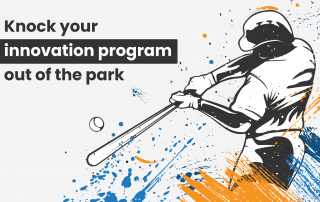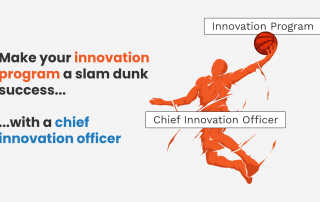Knock Your Innovation Program Out of the Park
It’s in our nature to support a cause that’s bigger than ourselves—we’re social creatures after all, so we’re at our best when we work together towards a common goal. However, out of left field came the global health pandemic, and collaboration has since taken a major hit at a time when creative ideas and solutions are needed most. That’s because the free-flow of information and exchange of ideas between internal and external stakeholders are the lifeblood of an innovative organization, and now more than ever is the time to drive virtual innovation campaigns that support company wide innovation initiatives around emerging market trends and new technologies such as AI, automation and digital transformation.
Build It and They Will Come
In the 1989 film Field of Dreams, Iowa corn farmer Ray Kinsella, played by Kevin Costner, hears a voice telling him “If you build it, they will come,” which Ray interprets as an instruction to build a baseball diamond in his fields. After building it, the spirits of baseball players emerge from the cornfields to play ball. Coincidentally, in our field of reality, Major League Baseball is perhaps the only major sports league to resume operations this summer as it prepares to throw its first pitch in July. Indeed, America’s favorite pastime may become America’s only pastime… with not a single soul to be found in the bleachers. And yet, that’s not stopping the league or its fans. Even if it’s held exclusively online, baseball is likely to bring an entire nation together, because that’s what sports do and what human nature demands. Innovation, for all intents and purposes, plays a similar function in the corporate setting because it engages your workforce in the same way sports do, as employees are brought together to participate in something bigger than themselves.
Home Field Advantage
Innovation is not all that different to a team sport. In the same way that fans support their team by wearing their colors and cheering them on, your employees support your company by continuously voicing their ideas and collaborating to develop the best ones. There’s a reason why a baseball team playing in its home stadium has ‘home field advantage’. Giving your employees a stake in the game, having them take part in the action and witnessing in real-time the fruits of their labor is rewarding and empowering for all parties involved in the innovation and creative problem-solving lifecycle. Leadership is critical for innovation to be a home run hit however. Innovation advocates are your MVPs because they’re the Ray Kinsellas of your organization’s success stories, without whom an innovation program would never make it to first base. You can’t expect your employees to root for your company’s success or have a stake in your company’s future if they’re not guided and engaged. That’s why it’s crucial for company leaders, specifically the Chief Innovation Officer, to step up to the plate and build a culture that is conducive to innovation.
Hey, Batter Batter
Innovation is not about quantity, but rather quality. Similarly, batting average (used to measure a hitter’s success at the plate) is not about hitting the ball per se, but rather hitting the ball safely, so that batters can advance from first, second and third base to reach the home plate. Likewise, innovation is about advancing the development of specific applications across five distinct innovation activities, from targeting, ideation, incubation and business planning to commercialization. What is then needed is a sustainable approach to innovation management that is embedded into the company’s process framework. Aligning company wide innovation processes, activities, roles and objectives with corporate strategy means your organization is much more likely to focus its efforts on repeatedly identifying and solving problems that truly matter. This will result in a greater batting average among employees and ultimately have them hitting home run solutions on a regular basis. Some business challenges are a little more complex than others however, and therefore require collaboration with expert problem solvers. These are your heavy hitters who have a favorable batting average and are capable of knocking the ball deep into the outfield whenever you’re hit with a curveball. If your organization lacks these skilled players, then consider a shuffle in the dugout.
Shuffle in the Dugout
Innovation is not immune to failure. Striking out is part of baseball just as it is of innovation. There’s a lot of hit-and-miss, but that doesn’t make the World Series any less attainable. If you find your innovation team is getting hit with too many curveballs though, then a shuffle in the dugout might be in order. After all, a team consisting exclusively of hitters will lose every time against a diverse team of pitchers, catchers and shortstops. Similarly, an organization that diversifies its stakeholder ecosystem and extends its crowdsourcing efforts beyond its immediate workforce is much more likely to improve company wide ideation, idea development and decision making, and possibly introduce net-new services that extend its core market value as a result. Well-planned innovation activities increase teamwork and collaboration among an organization’s local and global communities of employees, customers, suppliers, strategic partners and expert solvers. Leveraging intellectual capital on this scale and combining it with automated data analysis to surface relevant information for your online innovation campaigns will knock your innovation program out of the park; all you need to do is build it, and they will come.

Lucas Potasso-Justino
Chief Editor for the Future-Fit Manifesto. I Inspire people to push beyond their limitations to bring about the organizational change they desire and deserve. Follow me LinkedIn.
Propel Innovation with App Integrations
Imagine a world where innovation is magically embedded in all your favorite apps with the click of a button, and seamlessly flows through everyday work across the enterprise.
Imagine a world where your team can innovate without ever having to leave the tools they love or the tools your organization uses on a day-to-day basis.
Imagine a world where innovation can happen anywhere and anytime, or better yet, where innovation and cross-functional collaboration skyrocket into the stratosphere through task automation and automatic information discovery.
Gee whiz, I sure wish I lived in a world like that. Oh wait, I do. *Queue celebration 🎉*
Innovation app integrations are all the rage these days, and rightfully so: technology is evolving at an unprecedented rate, the global datasphere is multiplying to levels our brains can’t even begin to comprehend, and automation is permeating every aspect of work. So to make sense of the madness, we need to connect everything to everything, everyone to everyone, and everything to everyone. And we need to streamline it all. And automate it too. Can you feel the pressure mounting yet? I sure do.
« Integrations are no longer a luxury, but rather a necessity » – The guy who wrote this article
OK, melodrama aside, the reality is integrations are no longer a luxury, but rather a necessity (that’s right, I quoted myself). Organizations and individuals alike are increasingly looking for ways to streamline mundane and routine tasks, so they can use that extra brainpower and focus it on more important matters at hand, like coming up with creative ways to improve or innovate your company’s current offerings. Better yet, they can leverage that extra energy and time to collaborate with internal and external stakeholders, and together conjure up breakthrough ideas by scouting emerging tech or trends that extend your firm’s market value. Or maybe, just maybe, they can even use those resources to identify risks, or plan scenario-based activities so your organization can better prepare for the next crisis, whatever and whenever that may be.
As an added bonus, teams don’t even have to divert resources to adopting or adapting to new platforms; that’s the magic of integrations. Innovation becomes instantly embedded not only into the tools your team uses, but also into the work they do everyday. In other words, they can seamlessly and effortlessly innovate without ever having to exit their current applications, whether it’s Microsoft SharePoint, Microsoft Teams, or even Slack, to name a few.
So let’s say Bob is having a conversation with Sally on Slack about something Sally read in the news recently that got her attention, like this wacky new tech or trend that their company can seriously leverage to edge the competition. A simple conversation, which may or may not have to do with work, can suddenly spark a breakthrough business solution. So from within Slack, Sally decides to submit an idea to a challenge as part of a company wide innovation campaign. Now multiply these conversations times the number of interactions between teams or individual employees throughout your organization. And don’t stop there. Think of the external conversations employees can have or are having with external stakeholders, like customers, strategic partners, suppliers, researchers, R&D problem solvers, etc. The possibilities for future-proofing your organization become endless.
Now let’s talk about ideas, or more specifically, coming up with ideas. On the surface it sounds like an ideal concept: two employees having a conversation and BOOM, one of them comes up with a solid solution that turns a creative project into a winning business outcome. But there’s more to it than meets the eye: as previously mentioned, the collective sum of the world’s data is growing to levels we can’t even begin to grasp. According to IDC’s Data Age 2025: The Digitization of the World, the global datasphere is expected to explode from 33 Zettabytes in 2018 to 175 Zettabytes in 2025 (that’s 175,000,000,000,000,000,000,000 bytes for you numerophiles out there). To say that’s a lot of information is a serious understatement.
Even with all the brainpower you may have at your disposal, there’s no way in a million Zettabytes you can have humans comb through and sort all this information. But! what you can have is AI power do the heavy lifting by automatically curating and fetching articles and other relevant sources based on filters specified by humans. The result? Put simply, this means your team can leverage a constant stream of auto-curated content for endless inspiration and ideas to collaborate and build on. To put things into more tangible perspective, remember when the COVID-19 pandemic started? You kept seeing these articles about how company X predicted it, or how company Y used AI to anticipate a global catastrophe? Well, that’s the power of AI, data, collaboration, and human ingenuity, all of which can now be combined with a simple click of a button.
Check out our innovation app integrations directory to learn more, or schedule a consultation with one of our experts to see our innovation app integrations in action!
What Does the Future of Business Look Like?
Goooooooooooooooooooood day folks!
Let’s play a game of… spot the difference! Come on! I’ll make it worth your while. In fact, I’ll even raise the stakes: if you win, you get our complimentary research report on What The Future Looks Like. If you lose, you uh… come out of this having learned a very valuable lesson on business strategy… and you will still get a complimentary research report on What The Future Looks Like. Talk about a win-win!
So look at the three following quotes:
“Where is the future trend that will disrupt my current product roadmap? Can I see it coming, can I plan for it?”
« Planning for almost everything has been a long-term struggle. We are very reactive. »
« We thought climate change was going to be the black swan in five years. »
Now compare the quotes above to the ones directly below, and try to spot the MAIN difference between each set:
“We did a scenario planning a few years ago, and one of the scenarios we activated against was a global pandemic. That has come in handy!”
« We were paying attention to travel plans plans in early February; we took quick action on the technology front. »
« We designed our product for multiple scenarios – omni-channel, easy delivery/installation, multimodal, inventory. »
Did you spot the difference? Come on, even I was able to guess it! Yes, there is a stark contrast in sentiment between each set of quotes, but it’s much, MUCH more than just pessimism versus optimism, or failure versus success. You have to read between the lines!
Give up yet? Well I do, because I don’t have all day: whereas the individuals in the first set of quotes did NOT have an innovation management program, those in the second set of quotes DID.
Crazy, right? But not really. That’s what innovation management is all about. Yes, it’s about improving and innovating current business offerings on an ongoing basis, but it’s much, MUCH more than just that: it’s also about risk management, and planning for emerging trends and future disruptions. New technologies are always on the horizon; disruption is always right around the corner. Ultimately, the difference in long-term business success lies in being proactive versus being reactive. So what does the future of your business look like? I don’t know, but maybe your employees, customers, partners and suppliers do. Ask them! Give them a platform to identify, manage, and collaborate on the best ideas and solutions for your company, so you can stay ahead of the curve by preparing for whatever’s around the corner.
OK, so if you spotted the difference, kudos! Here’s our latest research report on What The Future Looks Like, on the house, as promised.
But I like you, so even if you didn’t spot the difference, here’s the research report anyway, as promised. In fact, I’m feeling rather generous today, so I’ll even throw in a free consultation should you be interested in learning how your organization can start planning for the next crisis, like another virus outbreak. Or an economic downturn. Or an environmental disaster. Or a digital disruption. Or whatever, you get the point. But that’s it! No more free stuff. There’s only so much I can give.
Til next time folks!
How Being Agile Can Help Your Company Win In The Post-Covid Economy
This article originally appeared on SalesTechStar
Amid the unprecedented economic uncertainty created by the Covid-19 pandemic, one thing is becoming clear. To survive – and even thrive – in the post-Covid economy, companies will have to be faster than ever in responding to change.
As yet, we can only surmise how quickly customers will book air travel again or how soon they will return to places like shopping malls. But there is already a marked shift in consumer behavior, with growing demand for touch-free payments, online sales and contact-free deliveries. These are likely only the tip of an iceberg of adjustments that will impact everything from how companies compete for sales, to which technologies they use, what their physical footprints look like and how they manage their supply chains.
What will separate those companies that continue to lead and those that falter is their ability to rapidly react to changing circumstances and bring new ideas to the marketplace. A proven way to do this is through the agile process. First created in the software industry around 20 years ago, the agile methodology is widely seen as the innovation engine that drives Silicon Valley’s success, and it has now been adopted by many companies beyond the tech sector. Regardless of a company’s industry or size, the agile process begins with putting customer needs first and building multidisciplinary, flexible teams that can quickly respond to change. These agile teams engage in a constant loop of ideating, building, testing and refining that enables them to quickly adjust products and services to meet changing customer expectations.
Deployed as part of a company-wide commitment to innovation, an agile approach can be transformative. Here are four key ways to build agility into an organization – and future-proof it against an increasingly uncertain economy.
Get the Ideas Flowing
Big, disruptive ideas may grab the most attention, but those come around less often than the ones that lead to incremental changes. Both continuous improvement and disruptive ideas can have a dramatic impact on your company’s bottom line. Instead of waiting for a breakthrough concept to appear, aim to capture as many thoughts as possible, as some may lead to substantial revenue increases. That has been the case for Honeywell, a major manufacturer. Recognizing the importance of continuous innovation, the company created a process for discovering and supporting ideas from across its business that could lead to both new and improved products. It was able to turn an idea for a robotic device that an employee had while raking his yard into a product that generated $8.5 million in revenue because its innovation process allowed it to capture such notions quickly and easily.
Be Bold and Experiment
A crucial part of the agile methodology is that it encourages experimentation by emphasizing building and testing features quickly. Now is the perfect time for businesses to embrace this approach and open the door to a wider range of possibilities than they might have considered before. Indeed, many are doing so and encouraging their employees to come up with innovative solutions to pressing challenges. The vital thing, however, is to put systems in place that allow these ideas to be quickly evaluated, and rapidly advance the best ones to the experimental stage where they can be tested. The results of these tests should be shared widely, so that everyone can learn from both the successful and the not-so-successful experiments. Embracing failure can be the hardest part of the innovation process, but it is an essential one – it’s just another step towards success.
Bring in Collaborators
At a time when huge numbers of people are speculating about how a “new normal” might look, those companies that collaborate with a wide range of stakeholders are most likely to detect new opportunities quickly. Strategic partnerships with universities and startup hubs are powerful ways for companies to keep their finger on the pulse of new technologies. But less formalized approaches like innovation jam sessions and competitions modeled on Shark Tank can be good ways to bring in people and ideas from outside your organization. These relationships with partner organizations can lead to important opportunities. For instance, Hollister Incorporated, a healthcare company, reacted to the pandemic by looking for ways to help deliver personal protective equipment. Through its internal innovation processes, it identified a material from one of its products that could be used by a partner organization to build life-saving N-95 face masks.
Spread Agile Innovation Throughout the Business
While rapid experimentation has its benefits, companies with mature innovation processes are those most likely to thrive over the long term. Many companies are held back because they silo innovation to specific initiatives, teams or time periods. Instead, build a robust process that will move the best ideas through an organization and allow them to get the support and funding they need to develop. Be sure to tie that process to your company’s overall strategic goals. To remain an innovator for years to come, your company needs not only to discover great ideas but to pursue them.
About the Author:
Ludwig Melik, CEO of Planbox
As a visionary thought leader and passionate technology advocate, Ludwig has the opportunity to work with some of the most innovative companies in the world every day. Sharing enterprise innovation success stories, design thinking methodologies and agile work processes are some of his ardent talking points. With 20+ years of experience in the project portfolio management and innovation management market, Ludwig looks to help organizations positively transform their work culture to create sustainable growth and ongoing success by galvanizing employee engagement and by igniting creative ideation. Connect with Ludwig on LinkedIn
Make Your Innovation Program a Slam Dunk Success with a Chief Innovation Officer
Goooooooooooooooooooood day folks!
You can fund innovation management all you want, but that alone might not be enough to achieve tangible results. Let’s look at your innovation program in basketball terms: whereas an innovation center with dedicated innovation managers make it a two-pointer, having a Chief Innovation Officer (CInO) will make it a three-pointer, and ultimately enable better and faster business value.
Innovation is a companywide program that brings together an array of internal and external stakeholders to continuously collaborate on identifying and developing the best ideas that are strategically aligned with company objectives. As such, innovation affects every facet of the business, from R&D to IT, to finance and operations, to name a few. And, in the same way that a CTO, CIO and CFO oversee their respective affairs, a CInO oversees companywide activities related to innovation. After all, you wouldn’t delegate all financial operations exclusively to a ‘finance center’ with dedicated financial managers, would you? So why do the same for innovation?
A basketball team, for example, can make major investments in a dazzling stadium decked out with jumbotrons, glitzy hoops and a shiny court, but what does that change in the team’s potential to succeed if it doesn’t have a seasoned coach at the helm? It’s up to the coach, not the players, to call the shots once the ball is in play, just like it’s up to the CInO, not the employees, to embed innovation-related roles, processes and objectives into the company core. So, let’s look at a few things the Chief Innovation Officer needs to do to achieve these results:
- Extension of the CEO: The CInO needs to be on the same level as the company’s most senior leaders, and being an extension of the CEO means the CInO must be able to exert the necessary power that enables disruptive innovation.
- Communicating a clear vision: The CInO needs to be the company’s chief marketing officer of innovation, and in so doing must continuously communicate a clear, unifying innovation vision and values that sustain trust in innovation management throughout the organization.
- Embedding innovation: The CInO needs to ensure that innovation management is embedded in the company’s process framework by providing an end-to-end innovation management platform capable of supporting companywide solutions for all innovation phases across all innovation activities, such as targeting, ideation, incubation, business planning and commercialization.
- Extensive knowledge of agile: The CInO needs to have extensive knowledge of agile methods, as Agile’s core values and principles are rooted adapting and responding to change with greater efficiency, ultimately allowing the CInO to ensure innovators’ continuous progress by troubleshooting highly complex challenges.
- Socializing emerging technologies: The CInO needs to inspire the adoption and use of emerging technologies so the company can stay ahead of the competition.
To make your innovation program a slam dunk success, it’s important to grant your Chief Innovation Officer with the right level of influence; in the same way that a coach is an extension of team management, the CInO is an extension of the CEO’s arm, responsible for driving and orchestrating all innovation activities that ensure sustainable innovation across the enterprise, and that company investments in innovation ultimately pay off.
Til next time folks!
Source: https://www.forrester.com/report/The+Role+Of+Chief+Innovation+Officer/-/E-RES161078
Innovation Interview with Planbox CEO Ludwig Melik
Goooooooooooooooooooooood day folks!
Planbox CEO Ludwig Melik was recently interviewed on School For Startups Radio, where he shared some amazing behind-the-scenes insights on the extraordinary world of innovation, like how we at Planbox often see innovative organizations outperforming their counterparts by whopping 10 to 15% margin! Crazy! I know! Read some of the transcripts below to learn more, or listen to the interview in its entirety at the bottom! The choice is yours, friend!
Scaling and Commercializing an Idea:
« The world has changed a lot so you can’t really depend on the heroics of a few to sustain a business model because whatever you do, someone ends up doing it better, cheaper and faster eventually, so you have to keep coming up with new ideas and changing the way you work. So we’ve essentially introduced a software platform that allows you to connect with people inside your company, or work with people outside your company and then think about what are the problem areas that are worthwhile focusing on that could bring about breakthrough opportunities that transform the way you work, or just an interesting, novel idea that could potentially be worthwhile investigating, and the go through a process of working with the right people and subject matter experts to develop that idea, and then be able to scale it and commercialize it inside your business. So we essentially manage that entire process online with our solution. »
Aligning Your Innovation Goals with Business Strategy:
« The first thing you’re always trying to think about is what is the strategy of the company, what are you essentially trying to achieve, what are your corporate objectives, and the moment that conversation gets started, there’s a bunch of challenges that an organization is facing to try and make those things become a reality. So then our software serves as the solution that allows you to define the challenge and then invite the right people to try to submit solutions, and then work through the process of creating the right ideas and the new products and services you need to introduce to be able to meet your corporate objectives–but the premise is to always make sure that whatever you’re doing around innovation and new ideas ultimately aligns with the strategy of the company, so that you’re able to get the stakeholders’ and executives’ support to be able to obviously have the right funding and ultimately, you’re not doing work that would potentially be for nothing because it doesn’t meet the corporate objectives for this year so it’s just a bunch of ideas that kind of go no where fast. So we try to very carefully understand and configure the software to work in and around the challenges the organization is trying to tackle so these could be enterprise-wide problems that the company is experiencing and they want to find solutions for them or it could be specific problems that a business unit is trying to address. »
Expected Business Outcomes:
« When you think about a solution like ours, you’re not doing it for a meager outcome, you’re looking for something quite substantial, so often times we’ll see organizations look for ten times of an ROI on a solution like ours and that would be just for a very basic continuous improvement initiative. If they’re really looking to do the real kind of innovation where they’re trying to change their business, it wouldn’t be uncommon to see a return on investment that is really a multiple of a hundred, or a thousand times what they had essentially looked at investing in a solution like ours, and of course this really means that they’re introducing some pretty interesting new revenue-generating solutions in the marketplace, or they’re really optimizing their business by finding some really interesting cost reductions So that’s kind of the range of outcomes we would be looking to achieve, but they would always be fairly significant in nature. This kind of solution isn’t about ‘well you know, we’re running payroll, how do we make it a little more efficient and maybe take one person out of the equation so that this way we’re kind of saving the salary of that person.’ It’s a much more lofty goal of really sustaining the business and growing the business over time, so we often see innovative companies out-do their counterparts by a significant margin of anywhere between 10 to 15%, and a lot of that is essentially tied back to the kind of thinking that goes into a software like ours. »
Building a Sustainable Innovation Model:
« One of the first things an organization should spend a lot more time on is identifying the right problems to solve, and by doing that you’re either getting to the root cause of a problem you should be addressing, or you’re potentially finding this very interesting opportunity that could generate significant revenue for the business. […] We also noticed the nature of work had changed and obviously the world is changing, because companies can’t stay on course with existing products or services because they will eventually face disruption, so you have to have a second act, you have to continue to think about how you’re going to be dealing with shrinking product lifecycles, and that’s basically the premise of Planbox; it’s building a sustainable innovation model where you can continuously face transformation or technology change and proactively take advantage of them to better your business. »
Ludwig also explores Planbox’s history and founding, and effectively explains the FORCE of AGILE innovation, which in case you forgot is a methodology that is highly correlated with higher financial performance and increasing product profitability, as recently revealed in our Study of Product Team Performance and Innovation Processes.
You can listen to the the entire interview below.
Til next time folks!






